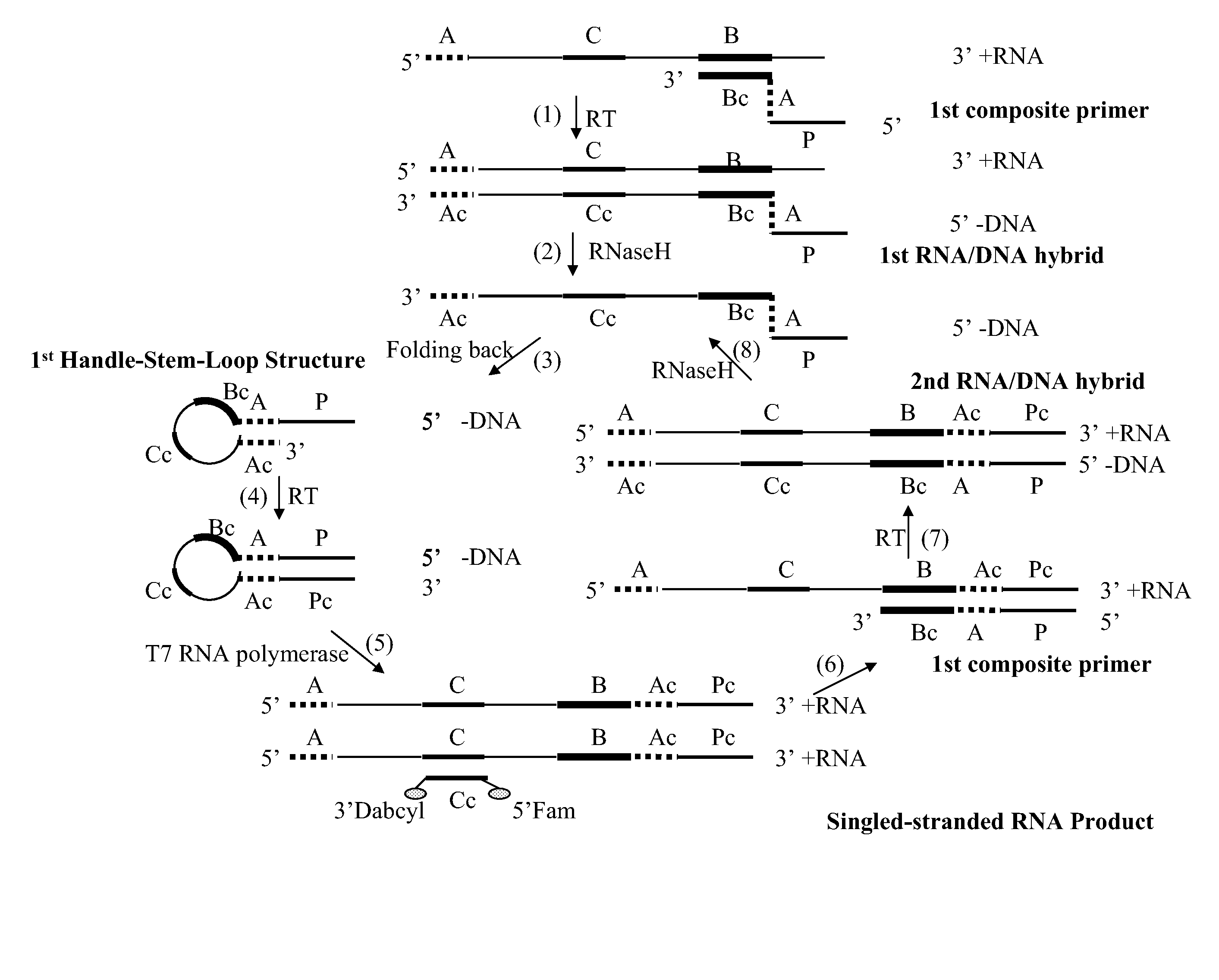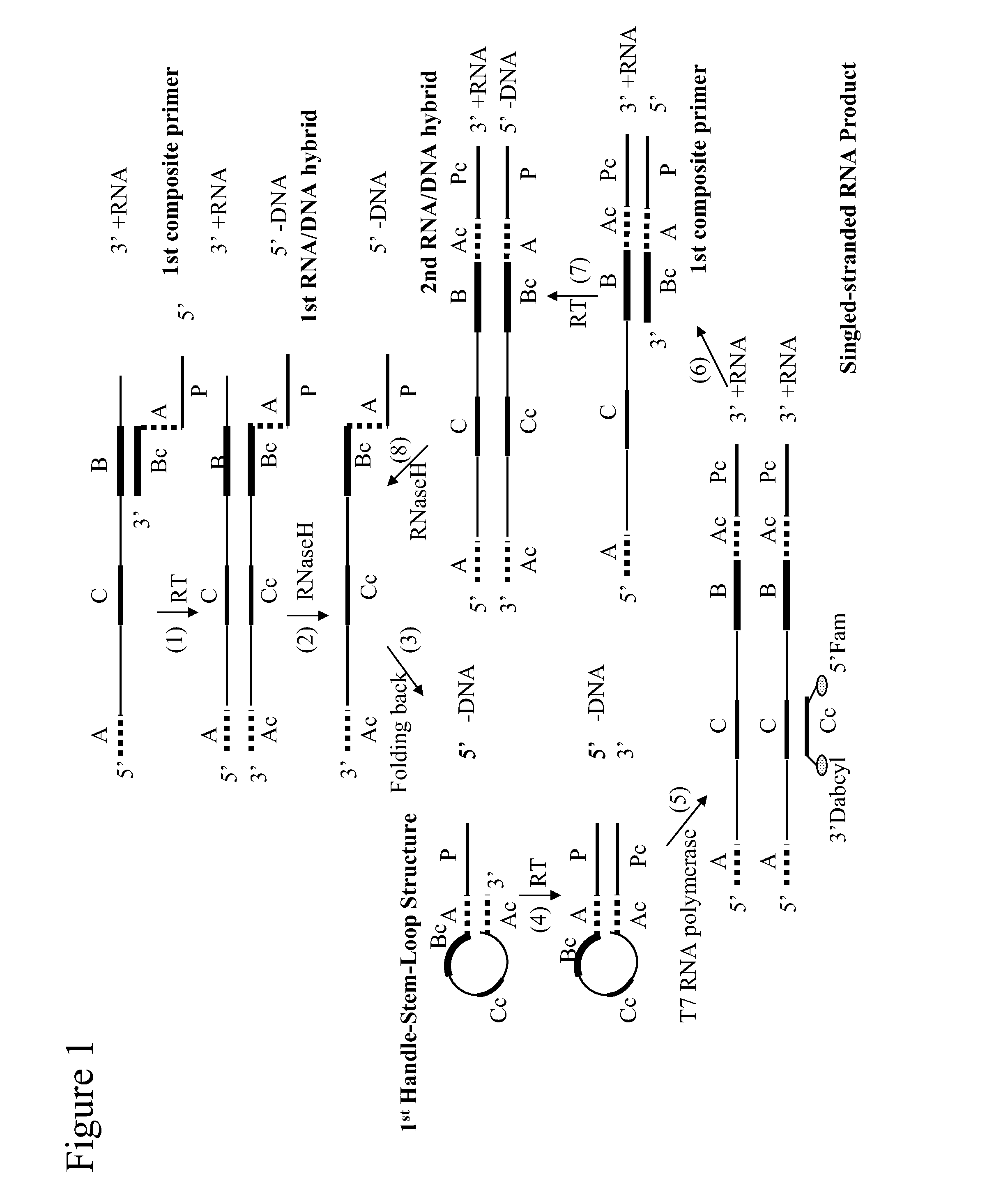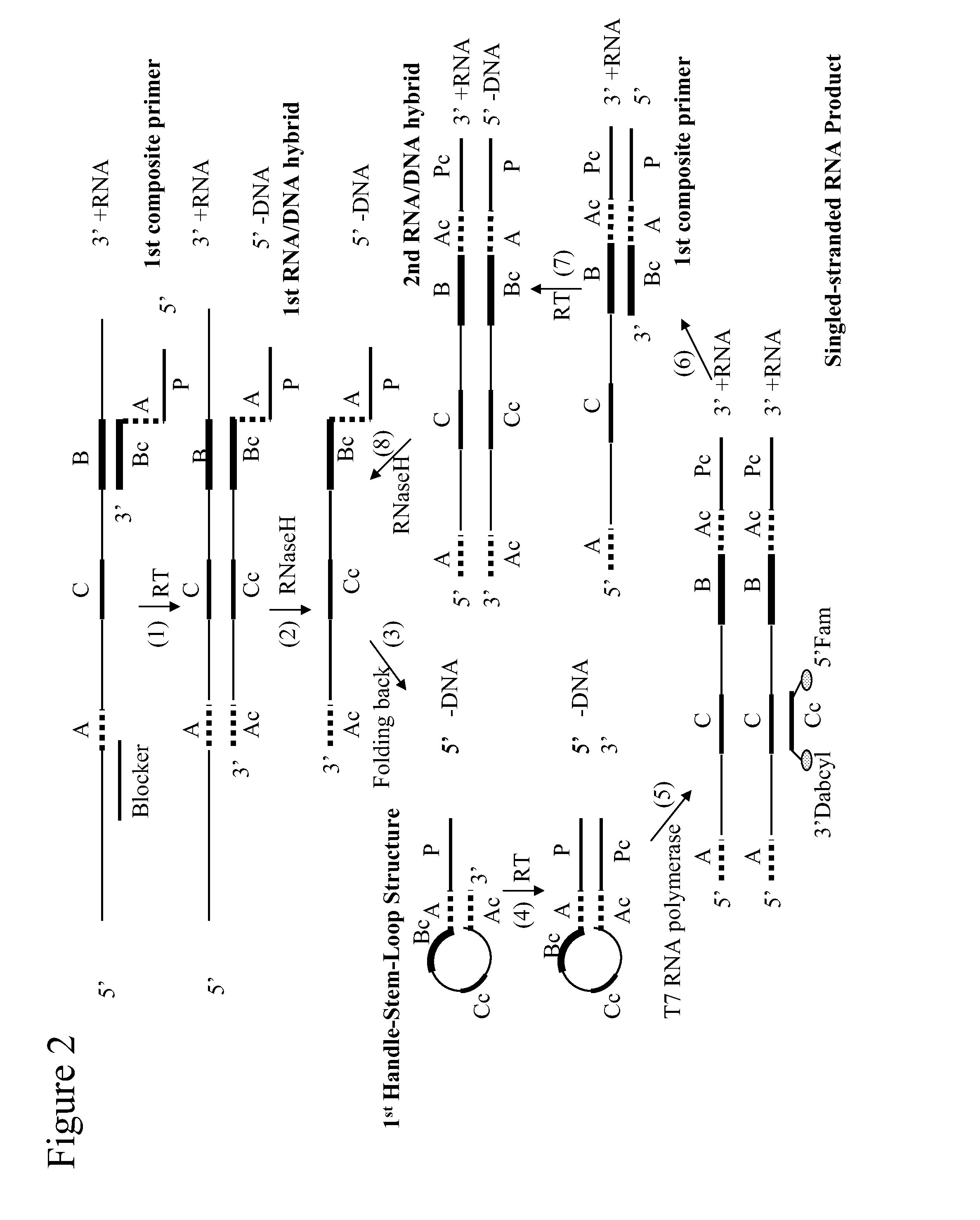Self-folding amplification of target nucleic acid
a target nucleic acid and amplification technology, applied in the field of selffolding amplification of target nucleic acid, can solve the problems of serious challenge to the reliability of assays, time-consuming and often challenging and difficult processes, and extremely difficult (if not impossible) to design and optimize two primers for amplification of small targets
- Summary
- Abstract
- Description
- Claims
- Application Information
AI Technical Summary
Benefits of technology
Problems solved by technology
Method used
Image
Examples
example 1
6.1 Example 1
Target-Specific Amplification with the Method of the Invention
[0134]The following experiment was conducted to evaluate isothermal amplification with a composite primer of the invention. HCV RNA was amplified using a method of the invention.
[0135]6.1.1 Materials and Methods
[0136]I. Oligonucleotides
[0137]1. Composite Primer
[0138]The composite primer had the following sequence and was used at 10 pmol / rxn:
(SEQ ID NO: 1)5′ AATTT AATAC GACTC ACTAT AGGGA GACTA GCCATGGGCA ATTCC GGTGT ACTCA 3′.
The nucleotides at position 1 to 27 constitute the T7 promoter sequence; the underlined section is the folding sequence; and the rest of the 3′ sequence is complementary to a portion of HCV RNA.
[0139]2. Detection Probe
[0140]The detection probe (a molecular beacon) had the following sequence and was used at 5 pmol / rxn:
(SEQ ID NO: 2)5′ Fam-CGUUC CGCAG ACCAC UAUGA ACG-Dabcyl 3′.
The nucleotides at position of 5 to 19 is complementary to a portion of an HCV RNA and can hybridize to the amplifie...
example 2
6.2 Example 2
Effect of Different Length of Folding Sequences in the Method of the Invention
[0159]The following experiment studied the effect of different length of folding sequence in the composite primer in a method of the invention.
[0160]6.2.1 Materials and Methods
[0161]The composite primer had one of the following sequence:
5′ AATTT AATAC GACTC ACTAT AGGGA GACTA GCCATGGGCA ATTCC GGTGT ACTCA 3′(SEQ ID NO: 1, with a folding sequence of 9bases),5′ AATTT AATAC GACTC ACTAT AGGGA GACTA GCCATGGCCG GCAAT TCCGG TGTAC TCA 3′(SEQ ID NO: 4, with a folding sequence of12 bases),or5′ AATTT AATAC GACTC ACTAT AGGGA GACTA GCCATGGCGT TAGGC AATTC CGGTG TACTC A 3′(SEQ ID NO: 5, with a folding sequence of15 bases).
The nucleotides at position 1 to 27 constitute the T7 promoter sequence; the underlined section is the folding sequence; and the rest of the 3′ sequence is complementary to a portion of HCV RNA.
[0162]Except that the HCV target was used at 10 pg per reaction, the detection probe, blocking sequ...
example 3
6.3 Example 3
Quantitative Detection of Target Nucleic Acid Using the Method of the Invention
[0167]The following experiment demonstrates that the methods of the invention can be used to perform quantitative detection of target nucleic acid, using HCV RNA transcripts as an example.
[0168]6.3.1 Materials and Methods
[0169]The composite primer had the following sequence:
5′ AATTT AATAC GACTC ACTAT AGGGA GACTA GCCATGGCGG GCAAT TCCGG TGTAC TCA 3′(SEQ ID NO: 4, with a folding sequence of 12bases, see underlined).
[0170]Except that the HCV target was used at 10 pg / reaction in this example, the detection probe, blocking sequence, reagents, machine, and experimental protocol were essentially the same as those described in Example 1.
[0171]6.3.2 Results
[0172]As shown in FIG. 11, when 10 pg, 1 pg or 0.1 pg of HCV RNA transcripts were added into the reaction, the Dt value was about 14 minutes (see line with closed circles: ——), 20 minutes (see line with closed squares: —▪—) or 28 minutes (see line w...
PUM
| Property | Measurement | Unit |
|---|---|---|
| pH | aaaaa | aaaaa |
| pH | aaaaa | aaaaa |
| length | aaaaa | aaaaa |
Abstract
Description
Claims
Application Information
 Login to View More
Login to View More - R&D
- Intellectual Property
- Life Sciences
- Materials
- Tech Scout
- Unparalleled Data Quality
- Higher Quality Content
- 60% Fewer Hallucinations
Browse by: Latest US Patents, China's latest patents, Technical Efficacy Thesaurus, Application Domain, Technology Topic, Popular Technical Reports.
© 2025 PatSnap. All rights reserved.Legal|Privacy policy|Modern Slavery Act Transparency Statement|Sitemap|About US| Contact US: help@patsnap.com



